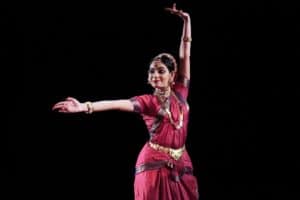Bharatnatyam is not just another Indian folk dance. The rich and diverse culture of India comprises of variety of art forms such as singing, acting etc. One of the most popularly known form of artistic expression available in the country is dancing. Now, Bharatanatyam, originating from the state of Tamil Nadu, is one of the most popular traditional “Indian Dance Form” in the country. However, there are elements in this South Indian dance style which clearly indicate that, it is much more than just a form of dancing. So, here is presenting a few reasons “Why” this classical style of dancing is more than just a traditional Indian Dance Form?

a. Origins of Bharatanatyam closely linked to the Natyashastra:
The theory of this style of dancing officially classified as a traditional Indian Dance Form, is said to have its foundations embedded in the ancient Sanskrit text based on performing arts known as “Natyashashtra”. The literature found in this book written by a scholar named Bharat Muni mainly discusses elements belonging to “drama and dance” (i.e. Natya). Furthermore, in this text concepts such as the theory of Lord Shiva’s Tandava dance, theory of rasa, bhava, expression, gestures, acting techniques, basic steps, and standing postures are discussed in details, all of which form an integral part of traditional Indian dance styles including the Bharatanatyam.
b. The key components involved in a Bharatanatyam performance:
According to the “Natyashashtra”, a “Bharatanatyam” performance is divided three components, and they include “Nritta, Nritya, and Natyam”. Now, the “Nritta” basically lays emphasis on elements related to “dance movements” such as motion, form, speed, and range. In terms of the “Nritya”, “gestures” are used to convey a spiritual message through a dance performance i.e. Nritta. Finally, the last component is the “Natyam” in which a solo performer or a group perform a story combining the elements of “Nritta and Nritya”.
c. The fusion of “Nritta” and “Nritya” to produce a Bharatanatyam performance:
“Dance with Drama” is what a Bharatanatyam performance eventually entails. And so, a performer or a group use facial expressions and hand gestures known as “Nritya” in unison with fluid “dance movements” known as “Nritta” to provide the final performance known as “Natyam or Bharatanatyam”.
d. The use of “Vachika” (i.e. Music) in the performance of Bharatanatyam:
“Carnatic music” that accompanies a Bharatanatyam performance also plays a major role in enabling a performer (or a group) narrate a story. Furthermore, it is through the fusion of elements such as a song written mainly in Tamil, Sanskrit, Telugu, and Kannada, its rendition by the singer, the music composed, and the overall rhythm of the composition,that a story is narrated. The instruments used mainly in composing music for this traditional Indian dance includes mridangam, nadaswaram, nattuvangam, flute, violin, and veena. Technically speaking, Vachika is the term used to describe this music that accompanies every Bharatanatyam performance.
And so, as can be seen it is the combination of elements belonging to “Dance and Drama” that makes Bharatanatyam more than just a traditional Indian dance form.
Image Credits: Wikimedia Commons Wikimedia Commons
